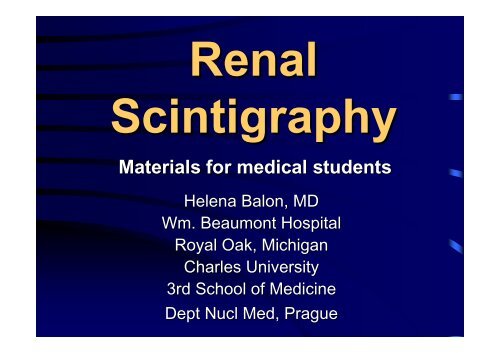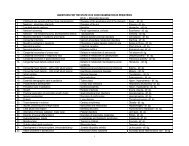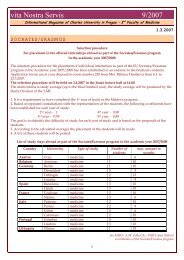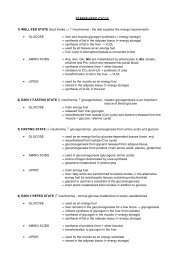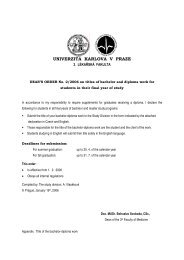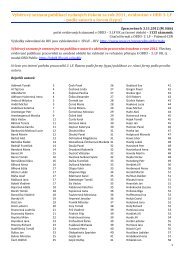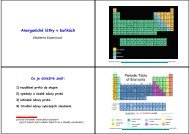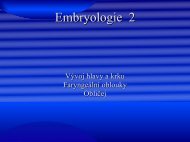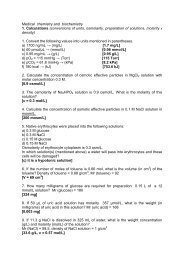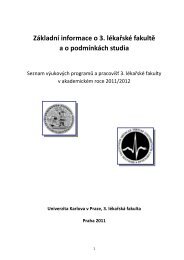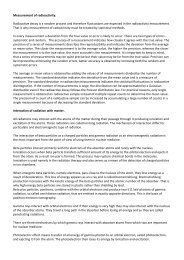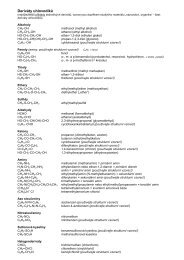Diuretic Renal Scan Interpretation
Diuretic Renal Scan Interpretation
Diuretic Renal Scan Interpretation
You also want an ePaper? Increase the reach of your titles
YUMPU automatically turns print PDFs into web optimized ePapers that Google loves.
<strong>Renal</strong><br />
Scintigraphy<br />
Materials for medical students<br />
Helena Balon, , MD<br />
Wm. Beaumont Hospital<br />
Royal Oak, Michigan<br />
Charles University<br />
3rd School of Medicine<br />
Dept Nucl Med, Prague
Indications<br />
Evaluation of:<br />
<strong>Renal</strong> perfusion and function<br />
Obstruction (Lasix(<br />
renal scan)<br />
Renovascular<br />
HTN (Captopril(<br />
renal scan)<br />
Infection (renal morphology scan)<br />
Pre-surgical<br />
quantitation (nephrectomy)<br />
<strong>Renal</strong> transplant<br />
Congenital anomalies, masses<br />
(renal morphology scan)
<strong>Renal</strong> Function<br />
Blood flow - 20% cardiac output to kidneys<br />
(1200 ml/min blood, 600 ml/min plasma)<br />
Filtration<br />
- 20% renal plasma flow filtered by<br />
glomeruli (120 ml/min, 170 L/d)<br />
Tubular secretion<br />
Tubular<br />
reabsorption (1% ultrafiltrate - urine)<br />
Endocrine<br />
functions
<strong>Renal</strong> Radiotracers<br />
Excretion Mechanisms<br />
GF TS TF<br />
Tc-99m DTPA >95%<br />
Tc-99m MAG3
<strong>Renal</strong><br />
Radiopharmaceuticals<br />
Extract. fraction<br />
Clearance<br />
Tc-99m DTPA 20% 100-120 ml/min<br />
Tc-99m MAG3 40-50% ~ 300 ml/min<br />
I-131 OIH ~100% 500-600 ml/min
<strong>Renal</strong> Radiopharmaceuticals<br />
Dosimetry<br />
DTPA MAG3 GHA DMSA I-131OIH<br />
rad/10 mCi<br />
rad/5mCi rad/300µCi<br />
Kidney 0.2 0.15 1.6 3.5 0.01<br />
Bladder 2.8 5.1 2.7 0.3 0.3<br />
EDE (rem) 0.3 0.4 0.4 0.3 0.03
Choosing <strong>Renal</strong><br />
Radiotracers<br />
Clin. Question<br />
Agent<br />
Perfusion<br />
Morphology<br />
Obstruction<br />
Relative function<br />
MAG3, DTPA, GHA<br />
DMSA, GHA<br />
MAG3, DTPA, OIH<br />
All<br />
GFR quantitation I-125<br />
iothalamate,<br />
Cr-51 EDTA, DTPA<br />
ERPF quantitation<br />
MAG3, OIH
Basic <strong>Renal</strong> <strong>Scan</strong><br />
Procedure
Basic <strong>Renal</strong> Scintigraphy<br />
Patient Preparation<br />
Patient must be well hydrated<br />
Give 5-105<br />
ml/kg water (2-4 4 cups)<br />
30-60 min. pre-injection<br />
Can measure U - specific gravity (
Basic <strong>Renal</strong> Scintigraphy<br />
Acquisition<br />
Supine position preferred<br />
Do not inject by straight stick<br />
Flow (angiogram) : 2-32<br />
3 sec / fr x 1 min<br />
Dynamic: 15-30 sec / frame x 20-30 min<br />
(display @ 1-31<br />
3 min/frame)
Basic <strong>Renal</strong> Scintigraphy<br />
Acquisition (cont’d)<br />
Obtain a 30-60 sec. image over injection site<br />
@ end of study<br />
if infiltration >0.5% dose<br />
clearance<br />
do not report<br />
Obtain post-void supine image of kidneys<br />
@ end of study<br />
Taylor, SeminNM 4/99:102-127
International Consensus<br />
Committee Recommendations for<br />
Tracer: MAG3, (DTPA)<br />
Basic Renogram<br />
Dose: 2 - 5 mCi adult, minimum 0.5 mCi peds<br />
Pt. position: supine (motion, depth issues)<br />
Include bladder, heart<br />
Collimator: LEAP<br />
Image over injection site<br />
Int’l Consens. . Comm.<br />
Semin NM ‘99:146-159159
DTPA normal
DTPA normal
Relative (split) function<br />
ROI’s
Relative uptake<br />
Contribution of each kidney to the total fct<br />
net cts in Lt ROI<br />
--------------------------------------- x 100%<br />
net cts Lt + net cts Rt ROI<br />
% Lt kid = ---------------------------------------<br />
Normal<br />
50/50 - 56/44<br />
Borderline<br />
57/43 - 59/41<br />
Abnormal<br />
> 60/40<br />
Taylor, SeminNM Apr 99
Time to peak<br />
Basic <strong>Renal</strong> Scintigraphy<br />
Processing<br />
Best from cortical ROI<br />
Normal < 5 min<br />
Residual Cortical Activity (RCA 20 or 30<br />
Ratio of cts<br />
Use cortical ROI<br />
20 or 30 )<br />
cts @ 20 or 30 min / peak cts<br />
Normal RCA 20 for MAG3 < 0.3<br />
Residual Urine Volume<br />
(post-void<br />
cts x void. vol) ÷ (pre-void<br />
cts - post void cts)
DTPA flow + scan<br />
GFR = 29 ml/’<br />
Creat = 2.0<br />
L= 33%<br />
R= 67%
<strong>Renal</strong> artery occlusion
Rt renal infarct
Renogram Phases<br />
I.<br />
Vascular phase (flow study):Ao<br />
Ao-to-Kid ~ 3” 3<br />
II.<br />
Parenchymal phase (kidney-to<br />
III.<br />
Washout (excretory) phase<br />
to-bkg):<br />
peak < 5’ 5<br />
): Tpeak
Renogram curves
Evaluation of<br />
Hydronephrosis<br />
<strong>Diuretic</strong> (Lasix(<br />
Lasix) ) <strong>Renal</strong> <strong>Scan</strong>
Obstruction<br />
Obstruction to urine outflow leads to<br />
obstructive uropathy<br />
(hydronephrosis, hydroureter)<br />
and<br />
may lead to obstructive nephropathy<br />
(loss of renal function)
<strong>Diuretic</strong> <strong>Renal</strong> <strong>Scan</strong><br />
Principle<br />
Hydronephrosis<br />
- tracer pooling in dilated<br />
renal pelvis<br />
Lasix<br />
induces increased urine flow<br />
If obstructed >>> will not wash out<br />
If dilated, non-obstructed obstructed >>> will wash out<br />
Can<br />
quantitate rate of washout (T 1/2<br />
1/2 )
<strong>Diuretic</strong> <strong>Renal</strong> <strong>Scan</strong><br />
Indications<br />
Evaluate functional significance of<br />
hydronephrosis<br />
Determine need for surgery<br />
obstructive<br />
hydronephrosis - surgical Rx<br />
non-obstructive<br />
obstructive hydronephrosis - medical Rx<br />
Monitor effect of therapy
<strong>Diuretic</strong> <strong>Renal</strong> <strong>Scan</strong><br />
Requirements<br />
Rapidly cleared tracer<br />
Well hydrated patient<br />
Good renal function
Pt. preparation:<br />
prehydration<br />
<strong>Diuretic</strong> <strong>Renal</strong> <strong>Scan</strong><br />
Procedure<br />
adults - oral or 360ml/m 2 iv over 30’<br />
peds - 10-15 15 ml/kg D5 0.3-0.45%NS<br />
0.45%NS<br />
void before injection<br />
bladder catheterization
<strong>Diuretic</strong> <strong>Renal</strong> <strong>Scan</strong><br />
Procedure (cont’d)<br />
Tracers:<br />
Tc-99m MAG3 5-105<br />
mCi<br />
(preferred over DTPA)<br />
Acquisition: supine until pelvis full<br />
(can switch to sitting post- Lasix)<br />
Flow (angiogram) : 2-32<br />
3 sec / fr x 1 min<br />
Dynamic:<br />
15-30 sec / frame x 20-30 min
<strong>Diuretic</strong> <strong>Renal</strong> <strong>Scan</strong><br />
Procedure (cont’d)<br />
Void before Lasix<br />
Lasix:<br />
40mg adult, 1mg/kg child iv<br />
@ ~10-20 min (when pelvis full)<br />
or @ -15min (“F-15(<br />
15” method)<br />
Acquisition for 30 min post Lasix<br />
Assess adequacy of diuresis<br />
Measure voided volume<br />
Adults produce ~200-300 ml urine post-Lasix
<strong>Diuretic</strong> <strong>Renal</strong> <strong>Scan</strong><br />
Procedure (cont’d)<br />
Don’t t give Lasix if<br />
Collecting system still filling<br />
Collecting system not full by 60 min<br />
Collecting system drains spontaneously<br />
Poor<br />
ipsilateral fct (< 20%)
pre-Lasix
post-Lasix
No UPJ obstruction<br />
T1/2<br />
R = 6’ 6<br />
L = 2’ 2
Post-Lasix<br />
curve
Pre-Lasix<br />
10 y/o M
Post-Lasix
Rt UPJ obstruction<br />
T1/2<br />
R = N/A<br />
F/U - nephrostomy tube placed
Lt hydronephrosis<br />
3-wk old baby<br />
3164897
Lt UPJ obstruction<br />
3164897
Rt UPJ obstruction<br />
T1/2<br />
R = N/A<br />
F/U - nephrostomy tube placed
Lt UPJ obstruction<br />
3164897
ROI placement<br />
<strong>Diuretic</strong> <strong>Renal</strong> <strong>Scan</strong><br />
Processing<br />
around whole kidney or<br />
around dilated renal collecting system<br />
T/A curve<br />
T 1/2<br />
from<br />
Lasix injection vs. from diuretic response<br />
linear<br />
vs. . exponential fit of washout curve
<strong>Diuretic</strong> <strong>Renal</strong> <strong>Scan</strong><br />
Washout<br />
(diuretic response)<br />
T1/2<br />
time required for 50% tracer to leave<br />
the dilated unit<br />
i.e. time required for activity to fall<br />
to 50% of peak
T washout<br />
1/2 cts<br />
100%<br />
50%<br />
T 1/2 min
T value<br />
1/2 Variables influencing T1/2T<br />
value:<br />
Tracer<br />
State of hydration<br />
Volume of dilated pelvis<br />
Bladder catheterization<br />
Dose of Lasix<br />
<strong>Renal</strong> function (response to Lasix)<br />
ROI (kidney vs. pelvis)<br />
T 1/2 calculation (from inj. . vs. response, curve fit)
Normal<br />
Obstructed<br />
T1/2<br />
< 10 min<br />
> 20 min<br />
Indeterminate<br />
10 - 20 min<br />
Best to obtain own normals for each<br />
institution, depending on protocol used
<strong>Diuretic</strong> <strong>Renal</strong> <strong>Scan</strong><br />
<strong>Interpretation</strong><br />
Interpret whole study, not T alone<br />
1/2 Visual (dynamic images)<br />
Washout curve shape (concave vs. convex)<br />
T 1/2
<strong>Diuretic</strong> <strong>Renal</strong> <strong>Scan</strong><br />
Pitfalls<br />
False positive for obstruction<br />
Distended bladder<br />
Gross<br />
hydronephrosis<br />
T(transit time) = V (volume) ÷ F (flow)<br />
Poorly functioning / immature kidney<br />
Dehydration<br />
False negative<br />
Low grade obstruction<br />
Poorly functioning / immature kidney
Effect of catheterization (1)<br />
full bladder,<br />
no catheter
Effect of catheterization (2)<br />
with catheter<br />
in bladder
Effect of catheterization (3)<br />
without catheter<br />
with catheter
“F F minus 15”<br />
<strong>Diuretic</strong> Renogram<br />
Furosemide<br />
(Lasix)) injected 15 min before<br />
radiopharmaceutical<br />
Rationale: kidney in maximal diuresis,<br />
under maximal stress<br />
Some<br />
equivocals will become clearly<br />
positive, some clearly negative<br />
English, Br JUrol 1987:10-14<br />
Upsdell, Br JUrol 1992:126-132
Evaluation of<br />
Renovascular<br />
Hypertension<br />
Captopril <strong>Renal</strong> <strong>Scan</strong><br />
(ACEI Renography)
Renovascular Disease<br />
<strong>Renal</strong> artery stenosis (RAS)<br />
Ischemic nephropathy<br />
Renovascular<br />
hypertension (RVH)<br />
RAS ≠ RVH
Renovascular<br />
Hypertension<br />
Caused by renal hypoperfusion<br />
Atherosclerosis<br />
Fibromuscular<br />
dysplasia<br />
Mediated by renin - AT - aldosterone system<br />
Potentially curable by renal revascularization
Prevalence<br />
Renovascular<br />
Hypertension<br />
50y<br />
Severe HTN resistant to medical Rx<br />
Unexplained or post-ACEI impairment in ren fct<br />
HTN + abdominal bruits<br />
If these present - moderate risk of RVH (20-30%)
Renin-Angiotensin<br />
System<br />
Angiotensinogen<br />
Angiotensin I<br />
Angiotensin II<br />
Captopril<br />
Renin<br />
ACE<br />
RAS<br />
Aldosterone<br />
Vasoconstriction<br />
HTN
Effect of RAS on GFR
Diagnosis of RAS<br />
Gold std: angiography<br />
Initial non-invasive tests:<br />
ACEI<br />
renography<br />
Duplex<br />
sonography<br />
Other tests:<br />
MRA<br />
- insensitive for distal / segmental RAS<br />
Captopril<br />
test (PRA post-C.)<br />
- low sensitivity<br />
<strong>Renal</strong> vein renin levels
ACEI Renography
Off ACEI & ATII receptor blockers x 3-73<br />
7 days<br />
Off diuretics x 5-7d5<br />
No solid food x 4 hrs<br />
Patient well hydrated<br />
10 ml/kg water 30-60 min pre- and during test<br />
ACEI<br />
Captopril 25-50 50 mg po (crushed), 1 hr pre-scan<br />
Enalaprilat 40 µg/kg iv (2.5 mg max), 15 min pre-scan<br />
Monitor BP q 15 min<br />
ACEI Renography<br />
Patient Preparation
ACEI Renography<br />
Procedure<br />
Tracer:<br />
Protocol:<br />
Tc-99m MAG3 (or DTPA)<br />
1 day vs. . 2 day test<br />
1 1 day test: baseline scan (1-2 mCi) ) followed by<br />
post-Capto<br />
scan (8-10<br />
mCi)<br />
2 2 day test: post-Capto<br />
scan,<br />
only if abnormal >> baseline<br />
Acquisition:<br />
flow & dynamic x 20-30 min.
ACEI Renography<br />
Processing<br />
Relative renal uptake (bkg(<br />
corrected)<br />
Time to peak (T(<br />
p ) - from cortical ROI<br />
normal < 5 min<br />
RCA<br />
20 (20 min/peak ratio) - from cortical ROI<br />
normal < 0.3
ACEI Renography<br />
Grading renogram curves
ACEI Renography<br />
Diagnostic Criteria<br />
MAG3:<br />
ipsilateral parenchymal retention<br />
p.C.<br />
change in renogram curve by ≥ 1 grade<br />
RCA 20 increase by ≥ 15% (e.g. from 30% to 45%)<br />
T p increase by ≥ 2 min or 40% (e.g. from 5 to 7’) 7<br />
DTPA:<br />
ipsilateral decreased uptake<br />
Decrease in relative uptake ≥ 10%<br />
(e.g.from 50/50 to 40/60), change of 5-9% 5<br />
- intermediate<br />
change in renogram curve by ≥ 2 grades<br />
Consens. report JNM ‘96:1876<br />
Semin NM 4/99:128-145
ACEI Renography<br />
<strong>Interpretation</strong><br />
High probability RVH (>90%)<br />
Marked C-induced C<br />
change<br />
Low probability RVH (
Captopril <strong>Renal</strong> <strong>Scan</strong><br />
MAG 3
Captopril <strong>Renal</strong> <strong>Scan</strong> MAG3
Captopril <strong>Renal</strong> <strong>Scan</strong><br />
MAG 3
Captopril <strong>Renal</strong> <strong>Scan</strong><br />
MAG 3
ACEI Renography<br />
In normal renal function - sens/spec ~ 90%<br />
In poor renal fct / ischemic nephropathy,<br />
ACEI renography often indeterminate<br />
>>> do MRA, Duplex US, angio
Evaluation of <strong>Renal</strong><br />
Infection<br />
<strong>Renal</strong> Morphology <strong>Scan</strong><br />
(<strong>Renal</strong> Cortical<br />
Scintigraphy)
UTI<br />
VUR<br />
risk factor for PN,<br />
not all pts w PN have VUR<br />
PN may lead to scarring >>> ESRD, HTN<br />
early<br />
Dx and Rx necessary<br />
Clinical & laboratory Dx of renal involvement<br />
in UTI unreliable
<strong>Renal</strong> Cortical Scintigraphy<br />
Indications<br />
Determine involvement of upper tract<br />
(kidney) in acute UTI (acute pyelonephritis)<br />
Detect cortical scarring (chronic pyelonephr.)<br />
Follow-up post Rx
Tracers<br />
<strong>Renal</strong> Cortical Scintigraphy<br />
Tc-99m DMSA<br />
Tc-99m GHA<br />
Acquisition<br />
Procedure<br />
2-4 4 hrs post-injection<br />
parallel hole posterior<br />
pinhole post. + post. oblique (or SPECT)<br />
Processing: relative fct
Acute PN<br />
<strong>Renal</strong> Cortical Scintigraphy<br />
<strong>Interpretation</strong><br />
single or multiple “cold” defects<br />
renal contour not distorted<br />
diffuse decreased uptake<br />
diffusely enlarged kidney or focal bulging<br />
Chronic PN<br />
volume loss, cortical thinning<br />
defects with sharp edges<br />
Differentiation of AcPN vs. ChPN unreliable
<strong>Renal</strong> Cortical Scintigraphy<br />
“Cold Defect “<br />
Acute or chronic PN<br />
Hydronephrosis<br />
Cyst<br />
Tumors<br />
Trauma (contusion, laceration, rupture,<br />
hematoma)<br />
Infarct
DMSA<br />
parallel hole collimator
Normal DMSA<br />
pinhole<br />
LPO RPO
DMSA
Acute pyelonephritis<br />
DMSA<br />
post L<br />
post R<br />
LEAP<br />
LPO pinhole<br />
RPO
<strong>Renal</strong> Cortical Scintigraphy<br />
Congenital Anomalies<br />
Agenesis<br />
Ectopy<br />
Fusion<br />
(horseshoe, crossed fused ectopia)<br />
Polycystic<br />
kidney<br />
Multicystic<br />
dysplastic kidney<br />
Pseudomasses<br />
(fetal<br />
column of Bertin)<br />
(fetal lobulation, hypertrophic
DMSA<br />
horseshoe kidney<br />
parallel<br />
pinhole
DMSA<br />
Lt Agenesis<br />
parallel
GHA<br />
Crossed ectopia<br />
74%<br />
26%
Radionuclide<br />
Cystogram
Indications<br />
Evaluation of children with recurrent UTI<br />
30-50% have VUR<br />
F/U after initial VCUG<br />
Assess effect of therapy / surgery<br />
Screening of siblings of reflux pts.
Methods<br />
Direct<br />
Tc-99m S.C. or<br />
TcO4<br />
Advant.<br />
via Foley<br />
can do at any age<br />
Disadv.<br />
VUR during filling<br />
catheterization<br />
Indirect<br />
Tc-99m DTPA or<br />
Tc-99m MAG3<br />
i.v.<br />
no catheter<br />
info on kidneys<br />
need pt<br />
cooperation<br />
need good renal<br />
fct
Direct Cystography<br />
1 mCi S.C. in saline via Foley<br />
Fill bladder until reversal of flow<br />
(bladder capacity = (age+2) x 30<br />
Continuous imaging during filling &<br />
voiding<br />
Post void image<br />
Record<br />
volume instilled<br />
volume voided<br />
pre- and post- void cts
RN Cystogram vs.<br />
Advantages<br />
VCUG<br />
Disadvantages<br />
Lower radiation<br />
dose<br />
(5 vs 300 mrad to<br />
ovary)<br />
Smaller amount of<br />
reflux detectable<br />
Quantitation<br />
of<br />
post-void residual<br />
volume<br />
Cannot detect distal<br />
ureteral reflux<br />
No anatomic detail<br />
Grading difficult
Normal cystogram<br />
filling voiding post-void
A<br />
VUR - filling phase
VUR - voiding phase &<br />
post-void<br />
B
Post void residual<br />
volume<br />
RV =<br />
voided vol x post-void<br />
cts<br />
pre-void<br />
cts - post void cts
Reflux nephropathy<br />
16% 84%


